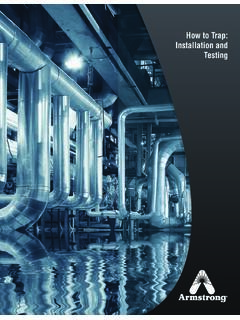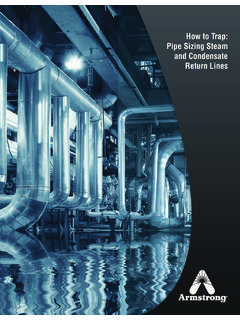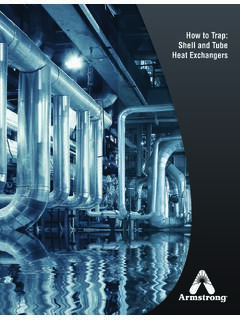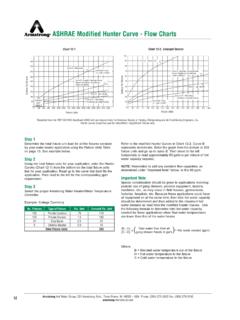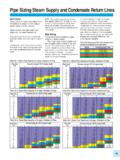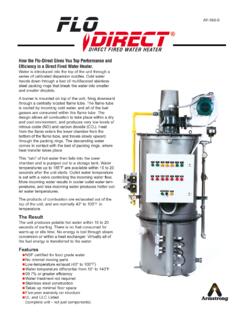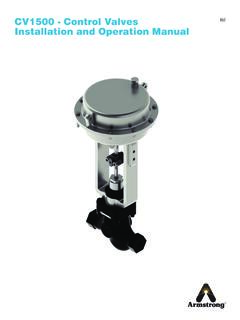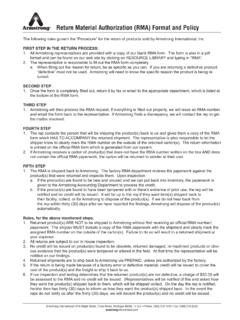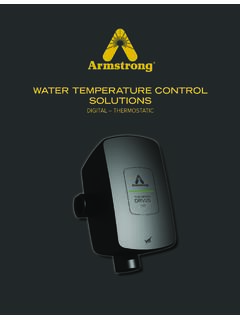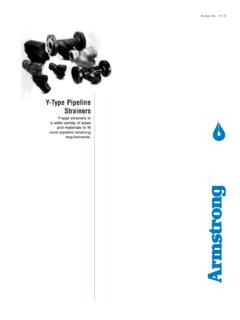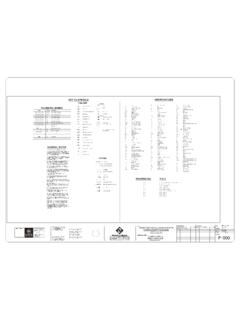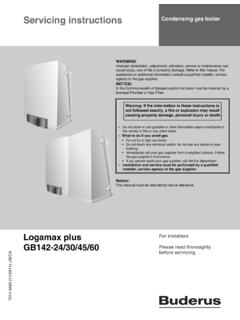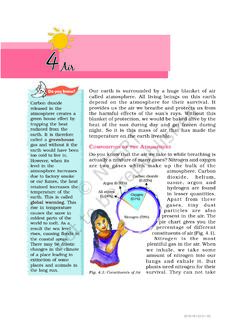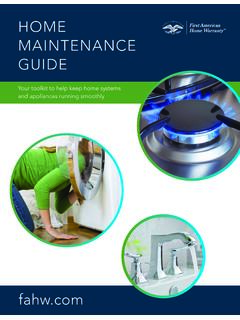Transcription of Steam Traps - Armstrong International
1 Catalog No. 108-CSteam TrapsInverted bucket, float andthermostatic, thermostaticand controlled disc steamtraps in carbon steel,stainless steel, forgedsteel and cast Energy Down to EarthSay energy. Think vice company that is energy conscious is also environ-mentally conscious. Less energy consumed meansless waste, fewer emissions and a short, bringing energy and environment togetherlowers the cost industry must pay for both. By helpingcompanies manage energy, Armstrong products andservices are also helping to protect the has been sharing know-how since weinvented the energy-efficient inverted bucket steamtrap in 1911. In the years since, customers savingshave proven again and again that knowledge notshared is energy wasted. 1997 Armstrong International , and materials are subject to change without of ContentsInverted Bucket Steam Trap Introduction6 Cast Iron Inverted Bucket Steam Traps8 Forged Steel Inverted Bucket Steam Traps10 Capacity Chart for Inverted Bucket Traps12 Series 2010 Stainless Steel Inverted BucketSteam Traps14 Series 1810 Stainless Steel Inverted BucketSteam Traps16 Series 1010 and U-1010 Stainless SteelInverted Bucket Steam Traps18 Cast Steel Inverted Bucket Steam Traps20 Automatic Differential Condensate Controllers22 float and Thermostatic Steam Trap Introduction24A&B Series float and Thermostatic Steam Traps26 Ultra-Capacity float and ThermostaticSteam Traps28 Thermostatic Wafer Traps30 Balanced Pressure Bellows Traps31 Radiator Traps33 Controlled Disc Steam Traps34 Capacities and Physical Data for ArmstrongSteam Traps in Metric Units354 Abbreviated Trap Selection and How to OrderTrap application assistanceis one of the most important partsof the complete trap
2 Service pro-vided by Armstrong Representatives arequalified by factory training andextensive field experience to assistyou in any trapping the representatives areArmstrong trapping specialistswho are available to assist withespecially difficult or to model size of pipe flanges are required,specify type of flange in maximum workingpressure that will orifice any options section only highlights thecomplete trap selection informationavailable in the Armstrong SteamConservation Guidelines for Con-densate Drainage, Handbook s Software Program 1( Steam Trap Sizing and Selection)is designed to be used in conjunc-tion with Handbook N-101 and thiscatalog. If you do not have Hand-book N-101 or your free copy ofSoftware Program 1, contact yourArmstrong installation and operation ofsteam trapping equipment shouldbe performed only by experiencedpersonnel. Selection or installationshould always be accompanied bycompetent technical assistance oradvice.
3 This catalog or its accompa-nying handbook should never beused as a substitute for suchtechnical advice or encourage you to contactArmstrong or its local representativefor further ConsiderationsUnit trapping is the use of a sepa-rate Steam trap on each condensingunit including, whenever possible,each separate chest or coil of asingle ll select most Traps with theaid of past experience. Either yours,the know-how of your ArmstrongRepresentative/Distributor or whatothers have learned in trappingsimilar sizing is simple withthe aid of Armstrong SoftwareProgram 1. Even if you don t haveaccess to this computer program,trap sizing is easy when you knowor can figure:1. Condensate loads in The safety factor to Pressure Maximum allowable Factor or Experience FactorSteam mains. Select Traps todischarge condensate produced byradiation installed between the boilerand the end of the Steam main: 2 installed at the end of themain or ahead of reducing andshutoff valves that are closed partof the time: 3 tracer lines.
4 On mosttracer line applications, the flow tothe Steam trap is surprisingly , the smallest trap isnormally equipment. Differentapplication requirements involvingconstant or variable Steam pressuredetermine which type of trap shouldbe used. The safety factor is depen-dent upon the type of equipmentbeing drained and the Constant Steam PressureA 2:1 or a 3:1 safety factor atoperating pressure Modulating Steam Traps and inverted buckettraps with thermic 0-15 psig Steam 2:1 psi pressure differential.(On F&T Traps SHEMA ratings can also be used.)2. 16-30 psig Steam 2:1 at2 psi pressure Above 30 psig Steam 3:1at 1/2 of maximum pressuredifferential across the Inverted bucket Traps withoutthermic buckets. Above 30 psigsteam pressure only 3:1 at .5of maximum pressure differentialacross the Bimetallic and wafer Traps Not recommended for low pressure Cast iron Traps not In welded stainless steel construction Condensate drainage is continuous, dischargeis Can be continuous on low Excellent when secondary Steam is Can fail closed due to Can fail either open or closed dependingupon the design of the ControllerFeatureCodeMethod of Operation(1) Intermittent ContinuousIntermittent(2) IntermittentContinuousEnergy Conservation (Time in Service)ExcellentGoodPoorFair(3) ExcellentResistance to WearExcellentGoodPoorFairExcellentCorros ion ResistanceExcellentGoodExcellentGoodExce llentResistance to Hydraulic ShockExcellentPoorExcellent(4) PoorExcellentVents Air and CO2 at Steam TemperatureYesNoNoNoYesAbility to Vent Air at Very Low Pressure (1/4psig)PoorExcellent(5)
5 NR GoodExcellentAbility to Handle Start-up Air LoadsFairExcellentPoorExcellentExcellent Operation Against Back PressureExcellentExcellentPoorExcellentE xcellentResistance to Damage from Freezing (6)GoodPoorGoodGoodGoodAbility to Purge SystemExcellentFairExcellentGoodExcellen tPerformance on Very Light LoadsExcellentExcellentPoorExcellentExce llentResponsiveness to Slugs of CondensateImmediateImmediateDelayedDelay edImmediateAbility to Handle DirtExcellentPoorPoorFairExcellentCompar ative Physical Size(7) LargeLargeSmallSmallLargeAbility to Handle Flash Steam FairPoorPoorPoorExcellentMechanical Failure (Open - Closed)OpenClosed(8) Open(9)OpenATable 5-1. How Various Types of Steam Traps Meet Specific Operating Requirements6 The Inverted Bucket Steam TrapVenting of Air and CO2 The Armstrong inverted bucketprovides continuous automatic airand CO2 venting with no coolinglag or threat of air Against Back PressureThe Armstrong inverted bucket hasexcellent performance against backpressure.
6 It has no adverse effecton inverted bucket operation otherthan to reduce its capacity by thelow differential. The bucket simplyrequires less force to pull the valveopen and cycle the From Dirt ProblemsArmstrong designed its invertedbucket to be virtually free of dirtproblems. The valve and seat areat the top of the trap, far away fromthe larger particles of dirt which fallto the bottom. Here the up-and-downaction of the bucket pulverizes the valve of an inverted bucketis either fully closed or open, dirtparticles pass freely. And the swiftflow of condensate from under thebucket s edge creates a uniqueself-scrubbing action that sweepsdirt out of the Efficient BecauseIt s So ReliableThe inverted bucket is the mostreliable Steam trap operating prin-ciple known. The heart of its simpledesign is a unique leverage systemthat multiplies the force provided bythe bucket to open the valve againstpressure. Since the bucket is openat the bottom, it resists damage fromwater hammer, and wearing pointsare heavily reinforced for long inverted bucket has only twomoving parts the valve leverassembly and the bucket.
7 Thatmeans no fixed points, no compli-cated linkages. Nothing to stick,bind or Energy Evenin the Presence of WearArmstrong inverted bucket Steam trapsopen and close based on the differ-ence in density between condensateand Steam the inverted bucketprinciple. They open and closegently, minimizing wear. Thissimple fact means that invertedbuckets are subject to less wearthan some other types of fact, as an Armstrong invertedbucket trap wears, its tight sealactually improves. The ball valveand seat of the Armstrong trapprovide essentially line contact resulting in a tight seal because theentire closing force is concentratedon one narrow seating Armstrong inverted bucket trapcontinues to operate efficiently withuse. Gradual wear slightly in-creases the diameter of the ballvalve. But the more it wears, thetighter the seal. The ball valve seatsitself deeper as wear increases,preserving a tight PartsThe stainless steel valve and seatof the Armstrong inverted bucketsteam trap are individually groundand lapped together in matchedsets.
8 All other working parts arewear- and corrosion-resistantstainless 6-1. Armstrong IB Valve Seating/Ball ValveFigure 6-2. IB Valve Wear CharacteristicsInfinite Number of Center Linesand Seating CircumferencesLine Contact Single SeatArmstrong IB ball valve seats itself deeperwith wear, preserving a tight Inverted Bucket TrapsVirtually no Steam lossSteam does not reach thewater-sealed discharge to damagefrom water hammerOpen bucket or float will not collapseas a result of water actionSnap opening of the valvecreates a momentarypressure drop and turbu-lence in the unit breaks up films ofcondensate and air andspeeds their flow to the operationSimple, direct operation withnothing to stick, bind or two moving parts thevalve lever and the from dirt problemsCondensate flow under the bottomedge of the bucket keeps sedimentand sludge in suspension until it isdischarged with the orifice opens wide and closestightly. No buildup of dirt nor closeclearances to be affected by airand CO2 ventingVent in top of bucket providescontinuous automatic air andCO2 venting with no cooling lagor threat of air binding.
9 Steampassing through vent is lessthan that required to compen-sate for radiation losses fromthe trap so it s not operationagainst back pressureSince trap operation is governedby the difference in density ofsteam and water, back pressure inthe return line has no effect on theability of the trap to open for con-densate and close against 7-1. Armstrong Inverted Bucket DesignWear and corrosionresistanceFree-floating guided lever valvemechanism is frictionless, andall wear points are heavily re-inforced. All working parts arestainless steel. Valve and seatare stainless steel, individuallyground and lapped together inmatched Check Valves arespring loaded stainless steeland screw directly into the trapinlet or into an extended inlettube having a pipe coupling atthe top to save fittings, laborand money. See Fig. Vent Buckets havea bi-metal controlled auxiliaryair vent for discharging largeamounts of air on for pressures up to250 psig. See Fig.
10 316 Stainless SteelBodies and all stainless steelinternals are available onModels 211, 212, 213 and216 of MaterialsTable 8-2. Series 800, 880 and 200 TrapsName of PartMaterialCap and BodyASTM A 48 Class 30 Inlet TubeSteel PipeGasketCompressed Non-asbestosBolt and Nut SetNo. 800, 880, 811, 881 Traps SAE Grade 5. All others SAE Grade 815 & 816 Bolt SetASTM A 193 Grade B7No. 815 Nut SetASTM A 563 Grade ANo. 816 Nut SetASTM A 194 Grade 2 HValve & Valve SeatStainless SteelValve RetainerStainless SteelLeverStainless SteelGuide Pin AssemblyStainless SteelBucketStainless Steel, Nos. 214, 814, and larger buckets have cast iron Thimble*Stainless Steel880 SeriesIntegral StrainerStainless SteelBushingSteelStrainer Bushing GasketSoft Steel*Models 815, 816 and Series 200 do not have Body with internal check valveinstalled directly into trap inlet andthermic vent in Ventin BucketInternalCheckValve For pressures to 250 to 20,000 lbs/hrTable 8-1.
